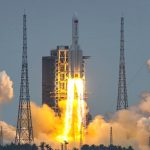A large segment of a Chinese Long March-5b rocket re-entered the Earth’s atmosphere and disintegrated over the Indian Ocean, China’s State television reported Sunday citing the China Manned Space Engineering Office.
This ended global fevered speculation over where the 18-tonne object would come down, with many in Nigeria’s capital Abuja expressing anxiety over reports that the debris, which was used to launch the first module of China’s new space station last month, could hit the Federal Capital Territory (FCT).
But the global television Chinese network, CCTV , providing coordinates for a point in the Indian Ocean, reported that “after monitoring and analysis, at 10:24 (0224 GMT) on May 9, 2021, the last-stage wreckage of the Long March 5B Yao-2 launch vehicle has re-entered the atmosphere, and the landing area is at 72.47°east longitude and 2.65° north latitude.”
The 18 tonnes Chinese rocket, one of the largest items in decades to have an undirected dive into the atmosphere, was originally injected into an elliptical orbit approximately 160 kilometres by 375 kilometres above Earth’s surface on 29 April.
Most of the vehicle was expected to have burned up when it made its final plunge through the atmosphere, although there is always the possibility that metals with high melting points, and other resistant materials, could survive to the surface.
When a similar core stage returned to Earth a year ago, piping assumed to be from the rocket was identified on the ground in Ivory Coast, Africa.
The chances of anyone actually being hit by a piece of space junk are very small, not least because so much of the Earth’s surface is covered by ocean, and because that part which is land includes huge areas that are uninhabited.
The zone of potential fall in this case is restricted still further by the trajectory of the rocket stage. It’s moving on an inclination to the equator of about 41.5 degrees. This means it’s possible already to exclude that any debris could fall further north than approximately 41.5 degrees North latitude and further south than 41.5 degrees South latitude.
The US on Thursday said it was watching the path of the object but currently had no plans to shoot it down.
“We’re hopeful that it will land in a place where it won’t harm anyone,” US Defense Secretary Lloyd Austin said. “Hopefully in the ocean, or someplace like that.”





